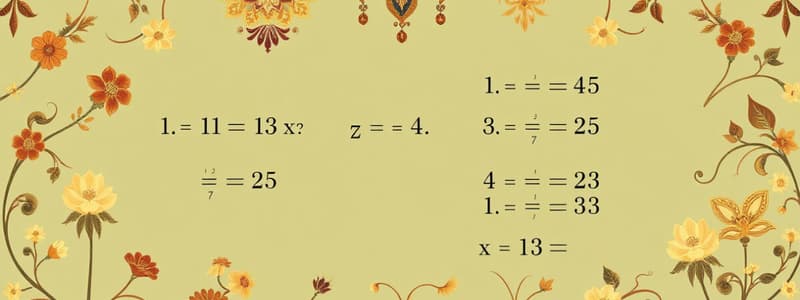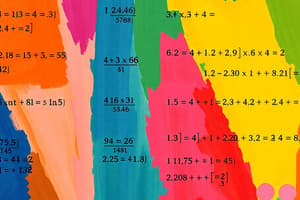Podcast
Questions and Answers
Lucy has 15 balloons. If she pops 4 balloons, how many balloons does she have now?
Lucy has 15 balloons. If she pops 4 balloons, how many balloons does she have now?
11 balloons
Tom has 12 cookies. If he gives 5 cookies to his friend, how many cookies does Tom have left?
Tom has 12 cookies. If he gives 5 cookies to his friend, how many cookies does Tom have left?
7 cookies
Jack has 10 toy cars. He buys 7 more. How many toy cars does Jack have in total?
Jack has 10 toy cars. He buys 7 more. How many toy cars does Jack have in total?
17 toy cars
Emma has 8 apples. If she picks 2 more from the tree, how many apples does she have now?
Emma has 8 apples. If she picks 2 more from the tree, how many apples does she have now?
Sara sees 19 birds in a tree. If 6 of them fly away, how many birds are still in the tree?
Sara sees 19 birds in a tree. If 6 of them fly away, how many birds are still in the tree?
Sam has 14 marbles. He wins 5 more in a game. How many marbles does Sam have altogether?
Sam has 14 marbles. He wins 5 more in a game. How many marbles does Sam have altogether?
Lily collected 20 seashells at the beach. If she gives away 8 to her friends, how many seashells does she have left?
Lily collected 20 seashells at the beach. If she gives away 8 to her friends, how many seashells does she have left?
Ryan has 9 toy soldiers. He finds 3 more under his bed. How many toy soldiers does Ryan have now?
Ryan has 9 toy soldiers. He finds 3 more under his bed. How many toy soldiers does Ryan have now?
Jessica has 17 stickers. If she uses 4 stickers for her project, how many stickers does she have remaining?
Jessica has 17 stickers. If she uses 4 stickers for her project, how many stickers does she have remaining?
David has 6 books. He buys 9 more from the store. How many books does David have in total?
David has 6 books. He buys 9 more from the store. How many books does David have in total?
Flashcards are hidden until you start studying
Study Notes
Word Problems for Second Grade
- Problems should involve basic arithmetic within the range of 1 to 20.
- Use simple and clear language suitable for second graders.
- Engage students with relatable scenarios (e.g., pets, toys, food) to make learning enjoyable.
Example Word Problem Structure
- Present a situation involving a character and an initial quantity (e.g., Max had 17 cats).
- Include an action that changes that quantity (e.g., he gave away 3).
- Ask a question that leads to the solution using subtraction (e.g., how many cats does Max have left?).
Characteristics of Effective Problems
- Keep sentences short and straightforward.
- Use concrete numbers to avoid confusion.
- Ensure the context is relevant to students’ everyday experiences.
Additional Sample Problems
- Maria had 12 apples. She ate 4 of them. How many apples does Maria have left?
- Jake counted 15 balloons. 5 balloons popped. How many balloons does Jake still have?
- Lucy had 10 crayons. She gave 2 to her friend. How many crayons does Lucy still have?
Learning Objectives
- Enhance basic subtraction skills.
- Develop problem-solving abilities through reading comprehension.
- Foster a love for math by connecting concepts to real-life situations.
Studying That Suits You
Use AI to generate personalized quizzes and flashcards to suit your learning preferences.



